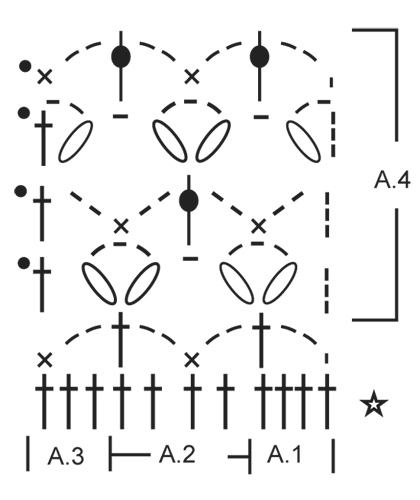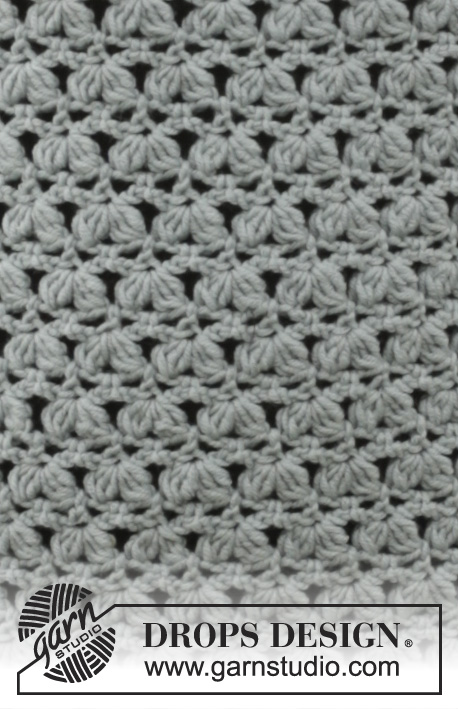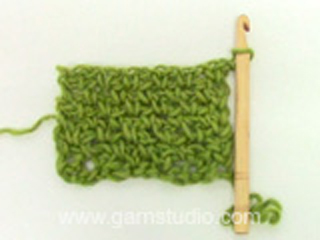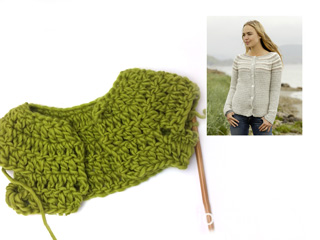Yesterday |
||||||||||||||||||||||
|
|
||||||||||||||||||||||
Crochet DROPS jumper with lace pattern, round yoke and detachable collar, worked top down in ”Merino Extra Fine”. Size: S - XXXL.
DROPS 156-18 |
||||||||||||||||||||||
|
PATTERN: See diagrams A.1-A.4. CROCHET INFO: Replace first tr on every round with 3 ch. Finish every tr round with 1 sl st in 3rd ch from beg of round. Replace first dc on every round with 1 ch. Finish every dc round with 1 sl st in 1st ch on round. INCREASE TIP: Inc 1 st by working 2 tr in 1 tr, first on one side of all markers on round, next time on the other side of all markers on round, continue inc like this. DECREASE TIP: Work 1 tr but wait with last pull through (= 2 sts on hook), then work next tr but on last pull through, pull yarn through all sts on hook = 1 tr dec. ---------------------------------------------------------- BODY: The piece is worked top down. Worked in the round from mid back. Work 93-98-103-113-118-128 ch on hook size 4.5 mm with Merino Extra Fine and form a ring with 1 sl st in first ch. Work next round as follows: 1 ch, 1 dc in first ch, 1 dc in each of the next 2 ch, * skip 1 ch, 1 dc in each of the next 4 ch *, repeat from *-* = 76-80-84-92-96-104 dc – READ CROCHET INFO. Then work an elevation in the back of neck as follows: ROUND 1 (= RS): Beg mid back, work 1 ch, 1 dc in 1st dc, * 1 ch, skip 1 dc, 1 dc in next dc *, repeat from *-* around the neck AT THE SAME TIME insert 1 marker after 38-40-42-46-48-52 sts (= mid front), turn piece. ROW 2 (= WS): Work 1 dc in every ch and 1 ch over every dc around the neck until 28-30-32-36-38-42 sts remain until marker, turn piece. ROW 3: Work 1 dc in every ch and 1 ch over every dc until 28-30-32-36-38-42 sts remain until marker, turn piece. ROW 4: Work 1 dc in every ch and 1 ch over every dc around the neck until 22-24-26-30-32-36 sts remain until marker, turn piece. ROW 5: Work 1 dc in every ch and 1 ch over every dc around the neck until 22-24-26-30-32-36 sts remain until marker, turn piece. ROW 6: Work 1 dc in every ch and 1 ch over every dc around the neck until 16-18-20-24-26-30 sts remain until marker, turn piece. ROW 7: Work 1 dc in every ch and 1 ch over every dc until 16-18-20-24-26-30 sts remain until marker, turn and work back to mid back. Then work in the round with tr AT THE SAME TIME on 1st round insert 19-20-21-23-24-26 markers in piece as follows: Insert 1st marker at beg of round (= mid back), then insert 18-19-20-22-23-25 markers 4 tr apart, after last marker there are 4 tr. Work in the round with tr AT THE SAME TIME inc 1 tr at all markers as follows: Inc every other round 5-6-6-5-5-6 times, and every 4th round 2-2-2-3-3-3 times - READ INCREASE TIP = 209-240-252-276-288-338 tr. Work a round while at the same time inc 14-7-7-7-19-5 tr evenly = 223-247-259-283-307-343 tr. REMEMBER THE CROCHET TENSION! On next round work as follows from mid back: 30-34-37-41-45-52 tr, 8 ch (under sleeve), skip 52-56-56-60-64-68 tr from previous round (to be used for sleeve later), 60-68-74-82-90-104 tr (front piece), 8 ch (under sleeve), skip 52-56-56-60-64-68 tr from previous round (to be used for sleeve later) and 29-33-36-40-44-51 tr = 135-151-163-179-195-223 tr/ch. Insert a marker, now measure piece from here! Work 1 tr in every tr/ch AT THE SAME TIME dec 8-8-8-12-12-12 sts evenly – READ DECREASE TIP = 127-143-155-167-183-211 tr. Continue to work as follows: Work A.1, A.2 30-34-37-40-44-51 repetitions in total in width, finish with A.3. Continue pattern like this. When A.1-A.3 have been worked 1 time vertically, repeat A.4 vertically until finished measurements. When piece measures 14-14-14-15-15-15 cm from marker, adjust so that next round is last round in A.4, inc 1 repetition of A.2 in 8th-9th-9th-10th-11th-13th repetition in ch-space as follows: Work 2 ch, 1 dc in ch-space, 2 ch, 1 tr in same ch-space, 2 ch, 1 dc in same ch-space. Work 14-16-19-20-22-25 repetitions of A.2, in next repetition of A.2 inc the same way. Then continue as before = 32-36-39-42-46-53 repetitions of A.2 in width. Fasten off when piece measures 34-34-36-35-37-37 cm from marker, adjust to finish with next to last round in A.4, piece measures 56-58-60-62-64-66 cm in total. SLEEVE: Sleeve is worked in the round, top down. Insert a marker, now measure piece from here! Beg by working mid under sleeve as follows: Work 1 dc in 5th ch of the 8 ch work in armhole on body, 3 ch (= 1 tr), work 1 tr in each of the next 3 ch, 1 tr in every tr over sleeve, then work 1 tr in each of the remaining 4 ch under sleeve = 60-64-64-68-72-76 tr. Insert 1 marker mid under sleeve. Continue to work as follows: 1 tr in each of the first 11-11-11-13-13-15 tr AT THE SAME TIME dec 1 tr (= 10-10-10-12-12-14 tr), A.1, A.2 8-9-9-9-10-10 times in width, A.3, work 1 tr in each of the last 10-10-10-12-12-14 tr. Continue with 1 tr in each of the 20-20-20-24-24-28 tr mid under sleeve and A.1-A.3 over sleeve. When A.1-A.3 have been worked 1 time vertically, repeat A.4 vertically until finished measurements. Continue this pattern AT THE SAME TIME when piece measures 4 cm, dec 1 tr on each side of marker - Remember DECREASE TIP. Repeat dec every 3½-3½-3½-2½-2½-2 cm 9-9-9-11-11-13 more times. Now work only A.1-A.3 over sleeve. Fasten off when sleeve measures 43½-42½-42½-39½-40-38 cm, adjust to finish with next to last round in A.4 – NOTE – shorter measurements in the larger sizes because of wider neck and shoulders. Work the other the same way. DETACHABLE COLLAR: Worked in the round. Work 99 ch on hook size 4.5 mm with Merino Extra Fine and form a ring with 1 sl st in 1st ch. Work 3rd row in A.1, 3rd row in A.2 23 times and 3rd row in A.3. Repeat A.4 vertically until finished measurements. When piece measures 8 cm, adjust so that next round is last round in A.4, inc 1 repetition of A.2 in each side of piece as follows: Work A.1, then work first A.2 as follows: Work 2 ch, 1 dc in ch-space, 2 ch, 1 tr in same ch-space, 2 ch, 1 dc in same ch-space. Work as before until 1 repetition of A.2 remains before A.3, in next repetition of A.2 inc the same way. Then work as before (= 25 repetitions of A.2 in width) until piece measures approx. 20 cm, adjust to finish with next to last row in A.4. Fasten off. |
||||||||||||||||||||||
Diagram explanations |
||||||||||||||||||||||
|
||||||||||||||||||||||

|
||||||||||||||||||||||

|
||||||||||||||||||||||
|
Have you made this or any other of our designs? Tag your pictures in social media with #dropsdesign so we can see them! Do you need help with this pattern?You'll find tutorial videos, a Comments/Questions area and more by visiting the pattern on garnstudio.com. © 1982-2024 DROPS Design A/S. We reserve all rights. This document, including all its sub-sections, has copyrights. Read more about what you can do with our patterns at the bottom of each pattern on our site. |
||||||||||||||||||||||



















































Comments / Questions (68)
Vorrei sapere alla fine della riga 5 quanti punti in totale devono rimanere. Io ho la taglia XL e mi restano 92 punti ma riesco a mettere solo 19 segnapunti. Grazie
05.01.2021 - 11:24DROPS Design answered:
Buongiorno Ivana, durante la lavorazione dei ferri accorciati non varia il numero di maglie. Buon lavoro!
05.01.2021 - 11:37Ik zie dat de vraag al eerder is gesteld maar zie geen antwoord. Mijn probleem doet zich voor bij het haken van de losse kraag. Bij de tweede toer wordt de kraag heel smal. Wat doe ik fout? Hoor graag. Groet Josine Leeuwerink
22.07.2020 - 13:15DROPS Design answered:
Dag Leeuwerink,
Er stond een fout in het patroon bij de kraag; dat is nu aangepast. Na het sluiten van de ring van lossen begin je gelijk met de 3e toer in het telpatroon.
19.11.2020 - 12:09I figured out the answer to my previous question, but I am having trouble understanding the increase every other round 6 times and every 4th round 2 times. How do I do that?
28.09.2019 - 03:06DROPS Design answered:
Dear Kim, you will work as follows: 1 round with increases, 1 round without increases; repeat these 2 rounds a total of 5 times, then work 1 round with increases (= every other round 6 times), and then work 3 rounds without increases, work 1 round with increases and repeat these 4 rounds a total of 2 times (= every 4th round 2 times). Happy crocheting!
30.09.2019 - 08:30In the very beginning on the repeat it says skip ch1, 1sc in each of the next 4sc. Am I doing a ch 1 between the sets of 4sc or am I just skipping a stitch? Also when I am counting the stitches in round 1 to place my marker, am I counting the ch 1 as a stitch or just the sc?
27.09.2019 - 21:56DROPS Design answered:
Dear Kim, the fundation chain is most ofen tighter than the first row so that you first cast on more chain stitches and skip some chains evenly on first row to get the correct number of stitches (and width) - if your chain stitches are large enough (as 1 sc) you can then cast on the number of stitches required on first row. Happy crocheting!
30.09.2019 - 08:19Ik ben nu al voor de 3e x begonnen aan toer 1-7. Ik zet en steekmarkeerder op st 36. Dan keer ik het werk tot ik weer 36 st heb voor de markeerder. Keer weer het werk tot 30 st voor de markeerder. Nu krijg ik als ik doorga aan 1 kant en verhoging een aan de andere zijde loopt de toer schuin af. Klopt dit, vindt het er beetje vreemd uitzien.
14.07.2019 - 19:40DROPS Design answered:
Dag Petra
Als het goed is haak je aan beide kanten 2 keer tot er 36 steken over zijn en aan beide kanten 1 keer tot er 30 steken over zijn voor de markeerdraad midden voor, voordat je keert en terug haakt. Dan zou het toch aan beide kanten gelijk moeten zijn?
15.07.2019 - 14:39Oui j’ai le bon échantillon. Mais si je fais comme vous au 1er tour il est impossible de passer la tête. J’ai déjà réalisé le pull et tout convient. Je ne vois pas pourquoi ça changerai pour le tout de cou alors que j’utilise le même crochet et la même laine.
19.02.2019 - 10:44DROPS Design answered:
Bonjour Mme Duchene, votre remarque va être transmise à nos stylistes, essayez d'ajouter quelques mailles en l'air dès le départ pour ajuster le col la la largeur souhaitée (4 mailles en plus par motif de A.2 en largeur en plus). Bon crochet!
19.02.2019 - 12:36Bonjour. Je ne comprends pas pour le col. J’ai suivi vos explications et rien que pour le début ça ne va pas. J’ai dû rajouter 2ml entre chaque br et chaque ms pour avoir la largeur nécessaire pour passer la tête. J’ai fait l’augmentation nécessaire à 8cm et continuer jusqu’à ce que le col fasse 20cm. Mais je n’ai pas cet effet large comme sur votre photo. Faut il faire d’autres augmentations? Merci de votre aide
18.02.2019 - 16:21DROPS Design answered:
Bonjour Mme Duchene, avez-vous bien le bon échantillon? Vous devez avoir 16 brides = 10 cm de large, et ainsi un total de 15 motifs en largeur (15 x A.2) + A.1 et A.3. Le tour de cou sera plus serré en haut (côté visage) et plus large en bas. Bon crochet!
19.02.2019 - 08:59Salve. È possibile che per fare questa maglia ci vogliono ben 850gr di lana per una taglia L? Ho già fatto un'altra maglia, nemmeno 500gr, e un cardigan, che non arriva ai 700gr. Mi sembrano eccessivi 850gr...o è a "causa" del motivo che viene un tale peso? Grazie
02.12.2017 - 18:37DROPS Design answered:
Buongiorno Alice. La quantità di lana indicata comprende anche la lana necessaria per realizzare il collo staccato, che di fatto è uno scaldacollo. Buon lavoro!
02.12.2017 - 19:54Angela Gibson wrote:
Hi, are there any corrections for this lovely design yet? For Rows 2-7 it would be far easier to put markers in foundation row & just say how many stitches to make than to count backwards from a marker (which does not specify if front or back even).
20.07.2017 - 10:44DROPS Design answered:
Dear Mrs Gibson, there are no correction to this pattern. You are working lace pattern in the round, A.1 shows how to start the rounds, repeat then A.2 and finish with A.3 - feel free to add as many markers as you need to be sure lace pattern works in the round. After diagram has been worked 1 time in height, repeat A.4 in height. Happy crocheting!
20.07.2017 - 15:19The instructions for the sleeves make no sense, bearing in mind that the sleeves are worked in an openwork pattern. Decreasing one treble in a row (as instructed) is not possible. Instead, I had to calculate how to decrease sections of the pattern every few rows, to shape the sleeve.
18.06.2017 - 14:10DROPS Design answered:
Dear Mrs Hayward, you are working tr mid under arm (= 20-24-28 tr (see your size) mid under arm) and lace pattern on remaining sts around, so that you can dec the tr mid under arm without decreasing lace pattern. Happy crocheting!
19.06.2017 - 09:12